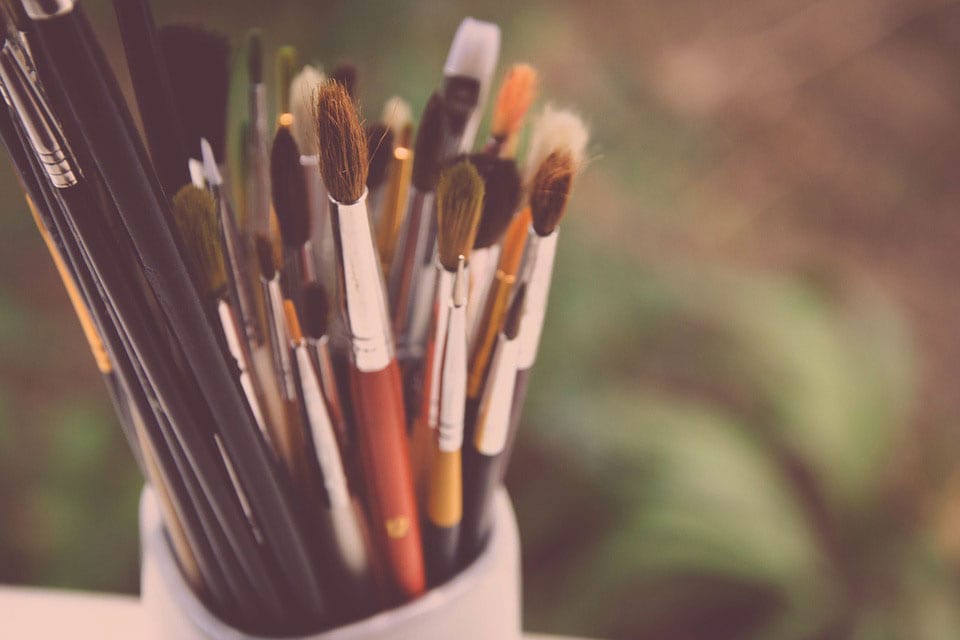As sourced from The Joplin Globe and the Lori Marble Blog, there are a lot of myths surrounding lefties. The minority among us, historically accused of witchcraft and dark magic, now just a quirky fun-fact for those we have come to understand as those who favor the right side of the brain, the hemisphere associated with creativity. Our handedness seems a firmly rooted part of our identities, locked in from the beginning of our written education.
While being a leftie is associated with the arts field, artist Lori Marble painted always with her right hand, associated with the left brain in charge of logic and mathematics. That was, until she developed hemi dystonia, a neurological condition that disrupts communication between the brain’s two hemispheres. Now, she paints with her left hand.
Her new exhibit “Right Brain, Left Hand,” displays the 44 works of art she has created since the surgery, made up of abstract mix medium works she made with her newly dexterous left-hand.
Dystonia
Dystonia is a rare neurological disorder that affects movement. The disease impedes on the brain’s two hemisphere’s ability to interact. This causes involuntary muscle contractions which can seem like tremors that can be painful and long-lasting. Such contractions can cause patients to twist the body into unnatural and uncomfortable postures. Symptoms vary from patient to patient and are based on the subtype, but they often include neck pain, foot cramps, trouble with speaking and writing, and eyelid spasms. The disease can be due to genetics or developed through other diseases.
Diagnosis to Deep Brain Stimulation
Lori Marbles’ issues with dystonia had been subtle. She had spasms that would cause her nail to dig into her hand and her feet to drag, and frequent spasms during sleep. The symptoms were manageable though, until one morning as she was taking her coffee down the stairs, the left side of her body failed her, and she tumbled down the stairs. In a blog post, Marble wrote,
“In landing at the bottom of seven steps, I knocked myself silly, impaled one of my favorite coffee mugs into my right leg, and had to have stitches above my right eye. I stayed overnight in the hospital for observation and was referred to a neuro-motion surgeon.”’
The spill led her to Joplin’s Mercy Hospital where specialists spotted her brain bleed. While previously she was told it was a condition she would just have to live with, this episode bought her to a new specialist who suggested she begin on deep brain stimulation surgery (DBS). This uses an artificial brain electrode to maintain better movement functioning. The treatment has been commonly used to treat Parkinson’s disease, a related movement disorder. First, she would need surgery to implant the device and to let her brain heal. She got it in February of 2019.
Post Surgery Abstract Art
As she recovered from the surgery, she noticed changes in her control over moving different parts of the body and her art. As a creative soul, she wanted to explore how the brain surgery had impacted her creativity.
As she set to work, she began the ‘Wonky Series’ to see the effect of the DBS. She painted 10 abstract before the electrode began to fire, and 10 after activation. While many dystonia patients don’t observe results for a year or year and a half from the beginning of treatment, Marbles was luckily to see immediate results.
Within an hour of the deal brain stimulation, she created her 11th art work, and she had already observed a change in her style. She wrote,
“The painting entitled Wonky 11 was painted within the first hour of being fully ‘bionic’! It’s this joyous, little fluid painting – lots of reds, golds, pinks and oranges. You can tell, when compared to the earlier pieces, that my movements were much more relaxed. I painted nine more following being ‘on’ as part of the initial DBS experience. Wonky 12-20.”
After that, her left-hand dominated. She continued to paint an abstract piece each day. She wrote, “Since that time, I have painted abstracts almost exclusively left-handed. I like them more, quite frankly.” She uses it to track changes and progress in her movement and mind and as a de-stressor. She credits her dystonia with changing her style and art process.
She has exhibited and sold her new works at Urban Art Gallery, Spiva Center for the Arts Small Works Auction, and Joplin Regional Artists Coalition.






